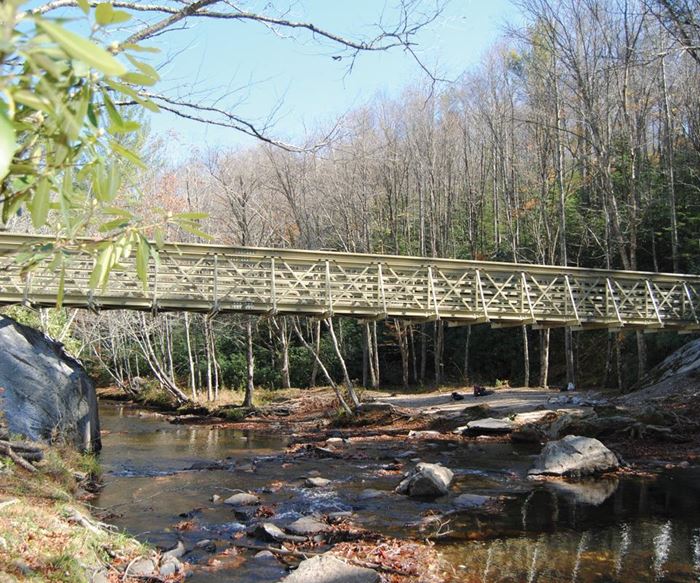Composites bridge the gap in an historic nature trail
Partially pre-assembled pultruded parts helicoptered in for quick, nature-sensitive assembly.
The well-loved Mountains-to-Sea Trail, the longest footpath in the US state of North Carolina, passes through 37 counties as it winds down from the Appalachian Mountains’ tallest peak to the sand dunes of the Outer Banks islands. Near the town of Blowing Rock, however, it used to be that hikers had to wade across Boone Fork Creek, which was not only annoying but also dangerous during high water flows. The nonprofit organization Friends of the North Carolina Mountains- to-Sea Trail secured funds, as part of an initiative to encourage more outdoor activity, to build a pedestrian bridge that would guarantee safe passage across the creek to hikers for decades to come.
Because the crossing point is in a remote US National Forest location with no vehicular access, conventional bridge-building methods, which require cranes and trucks to move metal trusses or concrete, weren’t feasible. Charged with responsibility for the bridge’s design and its construction supervision, Arete Engineers LLC (Boone, NC, US) knew that a lightweight, easily transported and assembled solution was needed. Arete’s primary engineer, T. Shawn Ausel, P.E., was familiar with Strongwell (Bristol, VA, US) and specified composite structural elements that could be ferried by helicopter to a drop site close to the build site.
The Arete design called for an overall 1.2m- wide by 25m-long bridge structure, constructed from EXTREN 525 pultruded fiberglass structural profiles wet out with UV-resistant polyester modified with fire-retardant additives. EXTREN components include a surface veil to prevent glass fibers from penetrating the resin surface and to enhance bridge corrosion and UV resistance. The profiles — 20-cm wide channels and 50-mm by 50-mm pultruded tubes — were pigmented olive green to better blend with the forest setting. Strongwell’s pultruded fiberglass SAFDECK 60-cm wide panels, also produced with fire-retardant polyester but then coated with an epoxy grit, were specified for the pedestrian deck surface.
Ausel and other Arete engineers worked closely with Strongwell from design through installation, and received training and guidance on element assembly. Many of the bridge elements were pre-fabricated by Strongwell, using epoxy adhesive to ensure a good fit and to cut assembly time at the job site. Holes were predrilled, enabling easier onsite assembly of the structure, using 316 stainless steel bolts, washers and nuts.
Materials were shipped on Aug. 22, 2016. Assembly was carried out on site by NHM Constructors LLC (Asheville, NC, US), took about four weeks, and was complete in time for an early October opening.
For more information about the Mountains- to-Sea Trail, visit www.ncmst.org.
Related Content
-
Composites end markets: Infrastructure and construction (2024)
Composites are increasingly used in applications like building facades, bridges, utility poles, wastewater treatment pipes, repair solutions and more.
-
Gatorbar, NEG, ExxonMobil join forces for composite rebar
ExxonMobil’s Materia Proxima polyolefin thermoset resin systems and glass fiber from NEG-US is used to produce GatorBar, an industry-leading, glass fiber-reinforced composite rebar (GFRP).
-
Recycling end-of-life composite parts: New methods, markets
From infrastructure solutions to consumer products, Polish recycler Anmet and Netherlands-based researchers are developing new methods for repurposing wind turbine blades and other composite parts.


















